Tupolev 154M noise asesment (Анализ шумовых характеристик самолёта Ту-154М)
Contents
1 The Noise Problem
2 Effects of Noise
2.1 Hearing Loss
2.2 Noise Interference
2.3 Sleep Disturbance
2.4 Noise Influence on Health
3 Noise Sources
3.1 Jet Noise
3.2 Turbomachinery Noise
4 Noise Measurement and Rules
4.1 Noise Effectiveness Forecast (NEF)
4.2 Effective Perceived Noise Level (EPNL)
5 Noise Certification
5.1 Noise limits
6 Calculations
6.1 Tupolev 154M Description
6.2 Noise calculations
6.2.1 Take-off Noise Calculation
6.2.2 Landing Approach Noise Claculation
7 Noise Suppression
7.1 Jet Noise Suppression
7.2 Duct Linings
7.2.1 Duct Lining Calculation
1 The Noise Problem
Though long of concern to neighbors of major airports, aircraft noise first became a major problem with the introduction of turbojet-powered commercial aircraft (Tupolev 104, Boeing 707, Dehavilland Comet) in the late 1950s. It was recognized at the time that the noise levels produced by turbojet powered aircraft would be unacceptable to persons living under the take-off pattern of major airports. Accordingly, much effort was devoted to developing jet noise suppressors, with some modest success. Take-off noise restrictions were imposed by some airport managements, and nearly all first-generation turbojet-powered transports were equipped with jet noise suppressors at a significant cost in weight, thrust, and fuel consumption.
The introduction of the turbofan engine, with its lower jet velocity, temporarily alleviated the jet noise problem but increased the high-frequency turbomachinery noise, which became a severe problem on landing approach as well as on take-off. This noise was reduced somewhat by choosing proper rotor and stator blade numbers and spacing and by using engines of the single-mixed-jet type.
2 Effects Of Noise
Noise is often defined as unwanted sound. To gain a satisfactory understanding of the effects of noise, it would be useful to look briefly at the physical properties of sound.
Sound is the result of pressure changes in a medium, caused by vibration or turbulence. The amplitude of these pressure changes is stated in terms of sound level, and the rapidity with which these changes occur is the sound's frequency. Sound level is measured in decibels (dB), and sound frequency is stated in terms of cycles per second or Hertz (Hz). Sound level in decibels is a logarithmic rather than a linear measure of the change in pressure with respect to a reference pressure level. A small increase in decibels can represent a large increase in sound energy. Technically, an increase of 3 dB represents a doubling of sound energy, and an increase of 10 dB represents a tenfold increase. The ear, however, perceives a 10-dB increase as doubling of loudness.
Another important aspect is the duration of the sound, and the way it is distributed in time. Continuous sounds have little or no variation in time, varying sounds have differing maximum levels over a period of time, intermittent sounds are interspersed with quiet periods, and impulsive sounds are characterized by relatively high sound levels and very short durations.
The effects of noise are determined mainly by the duration and level of the noise, but they are also influenced by the frequency. Long-lasting, high-level sounds are the most damaging to hearing and generally the most annoying. High-frequency sounds tend to be more hazardous to hearing and more annoying than low-frequency sounds. The way sounds are distributed in time is also important, in that intermittent sounds appear to be somewhat less damaging to hearing than continuous sounds because of the ear's ability to regenerate during the intervening quiet periods. However, intermittent and impulsive sounds tend to be more annoying because of their unpredictability.
Noise has a significant impact on the quality of life, and in that sense, it is a health problem. The definition of health includes total physical and mental well-being, as well as the absence of disease. Noise is recognized as a major threat to human well-being.
The effects of noise are seldom catastrophic, and are often only transitory, but adverse effects can be cumulative with prolonged or repeated exposure. Although it often causes discomfort and sometimes pain, noise does not cause ears to bleed and noise-induced hearing loss usually takes years to develop. Noise-induced hearing loss can indeed impair the quality of life, through a reduction in the ability to hear important sounds and to communicate with family and friends. Some of the other effects of noise, such as sleep disruption, the masking of speech and television, and the inability to enjoy one's property or leisure time also impair the quality of life. In addition, noise can interfere with the teaching and learning process, disrupt the performance of certain tasks, and increase the incidence of antisocial behavior. There is also some evidence that it can adversely affect general health and well-being in the same manner as chronic stress.
2.1 Hearing Loss
Hearing loss is one of the most obvious and easily quantified effects of excessive exposure to noise. Its progression, however, is insidious, in that it usually develops slowly over a long period of time, and the impairment can reach the handicapping stage before an individual is aware of what has happened.
Prolonged exposure to noise of a certain frequency pattern can cause either temporary hearing loss, which disappears in a few hours or days, or permanent loss. The former is called temporary threshold shift, and the latter is known as permanent threshold shift.
Temporary threshold shift is generally not damaging to human’s ear unless it is prolonged. People who work in noisy environments commonly are victims of temporary threshold shift.
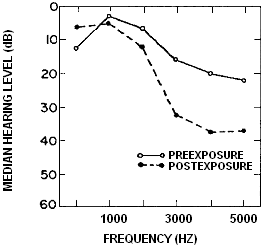
Figure 2.1 Temporary threshold shift for rock band performers.
Repeated noise over a long time leads to permanent threshold shift. This is especially true in industrial applications where people are subjected to noises of a certain frequency.
There is some disagreement as to the level of noise that should be allowed for an 8-hour working day. Some researchers and health agencies insist that 85 dB(A) should be the limit. Industrial noise level limitations are shown in the Table 2.1.
Table 2.1 Maximum Permissible Industrial Noise Levels By OSHA
(Occupational Safety and Health Act)
| Sound Level, dB(A) | Maximum Duration During Any Working Day (hr) |
| 90 | 8 |
| 92 | 6 |
| 95 | 4 |
| 100 | 2 |
| 105 | 1 |
| 110 | ½ |
| 115 | ¼ |
Noise-induced hearing loss is probably the most well-defined of the effects of noise. Predictions of hearing loss from various levels of continuous and varying noise have been extensively researched and are no longer controversial. Some discussion still remains on the extent to which intermittencies ameliorate the adverse effects on hearing and the exact nature of dose-response relationships from impulse noise. It appears that some members of the population are somewhat more susceptible to noise-induced hearing loss than others, and there is a growing body of evidence that certain drugs and chemicals can enhance the auditory hazard from noise.
Although the incidence of noise-induced hearing loss from industrial populations is more extensively documented, there is growing evidence of hearing loss from leisure time activities, especially from sport shooting, but also from loud music, noisy toys, and other manifestations of our "civilized" society. Because of the increase in exposure to recreational noise, the hazard from these sources needs to be more thoroughly evaluated. Finally, the recent evidence that hearing protective devices do not perform in actual use the way laboratory tests would imply, lends support to the need for reevaluating current methods of assessing hearing protector attenuation.
2.2 Noise Interference
Noise can mask important sounds and disrupt communication between individuals in a variety of settings. This process can cause anything from a slight irritation to a serious safety hazard involving an accident or even a fatality because of the failure to hear the warning sounds of imminent danger. Such warning sounds can include the approach of a rapidly moving motor vehicle, or the sound of malfunctioning machinery. For example, Aviation Safety states that hundreds of accident reports have many "say again" exchanges between pilots and controllers, although neither side reports anything wrong with the radios.
Noise can disrupt face-to-face and telephone conversation, and the enjoyment of radio and television in the home. It can also disrupt effective communication between teachers and pupils in schools, and can cause fatigue and vocal strain in those who need to communicate in spite of the noise. Interference with communication has proved to be one of the most important components of noise-related annoyance.
Interference with speech communication and other sounds is one of the most salient components of noise-induced annoyance. The resulting disruption can constitute anything from an annoyance to a serious safety hazard, depending on the circumstance.
Criteria for determining acceptable background levels in rooms have also been expanded and refined, and progress has been made on the development of effective acoustic warning signals.
It is now dear that hearing protection devices can interfere with the perception of speech and warning signals, especially when the listener is hearing impaired, both talker and listener wear the devices, and when wearers attempt to locate a signal's source.
Noise can interfere with the educational process, and the result has been dubbed "jet-pause teaching" around some of the nation's noisier airports, but railroad and traffic noise can also produce scholastic decrements.
2.3 Sleep Disturbance
Noise is one of the most common forms of sleep disturbance, and sleep disturbance is a critical component of noise-related annoyance. A study used by EPA in preparing the Levels Document showed that sleep interference was the most frequently cited activity disrupted by surface vehicle noise (BBN, 1971). Aircraft none can also cause sleep disruption, especially in recent years with the escalation of nighttime operations by the air cargo industry. When sleep disruption becomes chronic, its adverse effects on health and well-being are well-known.
Noise can cause the sleeper to awaken repeatedly and to report poor sleep quality the next day, but noise can also produce reactions of which the individual is unaware. These reactions include changes from heavier to lighter stages of sleep, reductions in "rapid eye movement" sleep, increases in body movements during the night, changes in cardiovascular responses, and mood changes and performance decrements the next day, with the possibility of more serious effects on health and well-being if it continues over long periods.
2.4 Noise Influence on Health
Noise has been implicated in the development or exacerbation of a variety of health problems, ranging from hypertension to psychosis. Some of these findings are based on carefully controlled laboratory or field research, but many others are the products of studies that have been severely criticized by the research community. In either case, obtaining valid data can be very difficult because of the myriad of intervening variables that must be controlled, such as age, selection bias, preexisting health conditions, diet, smoking habits, alcohol consumption, socioeconomic status, exposure to other agents, and environmental and social stressors. Additional difficulties lie in the interpretation of the findings, especially those involving acute effects.
Loud sounds can cause an arousal response in which a series of reactions occur in the body. Adrenalin is released into the bloodstream; heart rate, blood pressure, and respiration tend to increase; gastrointestinal motility is inhibited; peripheral blood vessels constrict; and muscles tense. Even though noise may have no relationship to danger, the body will respond automatically to noise as a warning signal.
3 Noise Sources
All noise emanates from unsteadiness – time dependence in the flow. In aircraft engines there are three main sources of unsteadiness: motion of the blading relative to the observer, which if supersonic can give rise to propagation of a sequence of weak shocks, leading to the “buzz saw” noise of high-bypass turbofans; motion of one set of blades relative to another, leading to a pure-tome sound (like that from siren) which was dominant on approach in early turbojets; and turbulence or other fluid instabilities, which can lead to radiation of sound either through interaction with the turbomachine blading or other surfaces or from the fluid fluctuations themselves, as in jet noise.
3.1 Jet Noise
When fluid issues as a jet into a stagnant or more slowly moving background fluid, the shear between the moving and stationary fluids results in a fluid-mechanical instability that causes the interface to break up into vortical structures as indicated in Fig. 3.1. The vortices travel downstream at a velocity which is between those of the high and low speed flows, and the characteristics of the noise generated by the jet depend on whether this propagation velocity is subsonic or supersonic with respect to the external flow. We consider first the case where it is subsonic, as is certainly the case for subsonic jets.
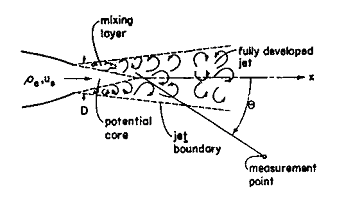
Figure 3.1 A subsonic jet mixing with ambient air, showing the mixing layer
followed by the fully developed jet.
For the subsonic jets the turbulence in the jet can be viewed as a distribution of quadrupoles.
3.2 Turbomachinery Noise
Turbomachinery generates noise by producing time-dependent pressure fluctuations, which can be thought of in first approximation as dipoles since they result from fluctuations in force on the blades or from passage of lifting blades past the observer.
It would appear at first that compressors or fans should not radiate sound due to blade motion unless the blade tip speed is supersonic, but even low-speed turbomachines do in fact produce a great deal of noise at the blade passing frequencies.
4 Noise Measurement and Rules
Human response sets the limits on aircraft engine noise. Although the logarithmic relationship represented by the scale of decibels is a first approximation to human perception of noise levels, it is not nearly quantitative enough for either systems optimization or regulation. Much effort has gone into the development of quantitative indices of noise.
4.1 Noise Effectiveness Forecast (NEF)
It is not the noise output of an aircraft per se that raises objections from the neighborhood of a major airport, but the total noise impact of the airport’s operations, which depends on take-off patterns, frequencies of operation at different times of the day, population densities, and a host of less obvious things. There have been proposals to limit the total noise impact of airports, and in effect legal actions have done so for the most heavily used ones.
One widely accepted measure of noise impact is the Noise Effectiveness Forecast (NEF), which is arrived at as follows for any location near an airport:
1. For each event, compute the Effective Perceived Noise Level (EPNL) by the methods of ICAO Annex 16, as described below.
2. For events occurring between 10 PM and 7 AM, add 10 to the EPNdB.
3. Then NEF = ![]() , where the sum is taken over all events in a 24-hour period. A little ciphering will show that this last calculation is equivalent to adding the products of sound intensity times time for all events, then taking the dB equivalent of this. The subtractor 82 is arbitrary.
, where the sum is taken over all events in a 24-hour period. A little ciphering will show that this last calculation is equivalent to adding the products of sound intensity times time for all events, then taking the dB equivalent of this. The subtractor 82 is arbitrary.
4.2 Effective Perceived Noise Level (EPNL)
The perceived noisiness of an aircraft flyover depends on the frequency content, relative to the ear’s response, and on the duration. The perceived noisiness is measured in NOYs (unit of perceived noisiness) and is plotted as a function of sound pressure level and frequency for random noise in Fig. 4.1.
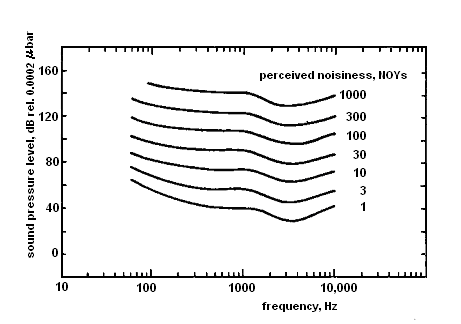
Figure 4.1 Perceived noisiness as a function of frequency and sound pressure level
Pure tones (frequencies with pressure levels much higher than that of the neighboring random noise in the sound spectrum) are judged to be more annoying than an equal sound pressure in random noise, so a “tone correction” is added to their perceived noise level. A “duration correction” represents the idea that the total noise impact depends on the integral of sound intensity over time for a given event.
The 24 one-third octave bands of sound pressure level (SPL) are converted to perceived noisiness by means of a noy table.
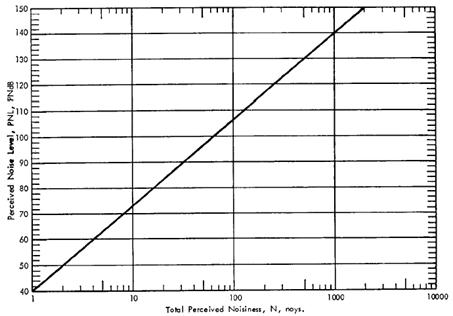
Figure 4.2 Perceived noise level as a function of NOYs
Conceptually, the calculation of EPNL involves the following steps.
1. Determine the NOY level for each band and sum them by the relation
![]() ,
,
where k denotes an interval in time, i denotes the several frequency bande, and n(k) is the NOY level of the noisiest band. This reflects the “masking” of lesser bands by the noisiest.
2. The total PNL is then PNL(k) = 40 + 33.3 log10N(k).
3. Apply a tone correction c(k) by identifying the pure tones and adding to PNL an amount ranging from 0 to 6.6 dB, depending on the frequency of the tone and its amplitude relative to neighboring bands.
4. Apply a duration correction according to EPNL = PNLTM + D, where PNLTM is the maximum PNL for any of the time intervals. Here
![]() ,
,
where Dt = 0.5 sec, T = 10 sec, and d is the time over which PNLT exceeds PNLTM – 10 dB. This amounts to integrating the sound pressure level over the time during which it exceeds its peak value minus 10 dB, then converting the result to decibels.
All turbofan-powered transport aircraft must comply at certification with EPNL limits for measuring points which are spoken about in the next chapter.
5 Noise Certification
The increasing volume of air traffic resulted in unacceptable noise exposures near major urban airfields in the late 1960s, leading to a great public pressure for noise control. This pressure, and advancing technology, led to ICAO Annex 16, AP-36, Joint Aviation Regulation Part 36 (JAR-36) and Federal Aviation Rule Part 36 (FAR-36), which set maximum take-off, landing and “sideline” noise levels for certification of new turbofan-powered aircraft. It is through the need to satisfy this rule that the noise issue influences the design and operation of aircraft engines. A little more general background of the noise problem may be helpful in establishing the context of engine noise control.
The FAA issued FAR-36 (which establishes the limits on take-off, approach, and sideline noise for individual aircraft), followed by ICAO issuing its Annex 16 Part 2, and JAA issuing JAR-36. These rules have since been revised several times, reflecting both improvements in technology and continuing pressure to reduce noise. As of this writing, the rules are enunciated as three progressive stages of noise certification. The noise limits are stated in terms of measurements at three measuring stations, as shown in Fig. 5.1: under the approach path 2000 m before touchdown, under the take-off path 6500 m from the start of the take-off roll, and at the point of maximum noise along the sides of the runway at a distance of 450 m.

Figure 5.1 Schematic of airport runway showing approach, take-off, and
sideline noise measurement stations.
The noise of any given aircraft at the approach and take-off stations depends both on the engines and on the aircraft’s performance, operational procedures, and loading, since the power settings and the altitude of the aircraft may vary.
The sideline station is more representative of the intrinsic take-off noise characteristics of the engine, since the engine is at full throttle and the station is nearly at a fixed distance from the aircraft. The actual distance depends on the altitude the aircraft has attained when it produced maximum noise along the designated measuring line. Since FAR-36 and international rules set by the International Civil Aviation Organization (ICAO annex 16, Part 2) which are generally consistent with it have been in force, airport noise has been a major design criterion for civil aircraft.
Stricter noise pollution standards for commercial aircraft, established by the International Civil Aviation Organization, came into effect worldwide on 1 April. Most industrialized countries, including all EU states, enforced the new rules and the vast majority of airliners flying in those states already meet the more stringent requirements. But some Eastern European countries are facing a problem, especially Russia. Eighty percent of its civilian aircraft fall short of the standards, meaning it will not be able to apply the new rules for domestic flights. Even more worrisome for Moscow is the fact that Russia could find many of its planes banned from foreign skies. Enforcement of the new rules could force Russia to cancel 11,000 flights in 2002, representing some 12 percent of the country's passenger traffic.
The new rules have been applied only to subsonic transports, because no new supersonic commercial aircraft have been developed since its promulgation.
5.1 Noise Limits
As mentioned above, all turbofan-powered transport aircraft must comply at certification with EPNL limits for the three measuring stations as shown in Fig. 5.1. The limits depend on the gross weight of the aircraft at take-off and number of engines, as shown in Fig. 5.2. The rule is the same for all engine numbers on approach and on the sideline because the distance from the aircraft to the measuring point is fixed on approach by the angle of the approach path (normally 3 deg) and on the sideline by the distance of the measuring station from the runway centerline.
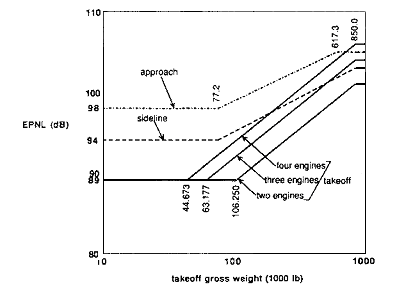
Figure 5.2 Noise limits imposed by ICAO Annex 16 for certification of aircraft.
On take-off, however, aircraft with fewer engines climb out faster, so they are higher above the measuring point. Here the “reasonable and economically practicable” principle comes into dictate that three-engine and two-engine aircraft have lower noise levels at the take-off noise station than four-engine aircraft.
There is some flexibility in the rule, in that the noise levels can be exceeded by up to 2 EPNdB at any station provided the sum of the exceedances is not over 3 ENPdB and that the exceedances are completely offset by reductions at other measuring stations.
6 Noise Level Calculations
6.1 Tupolev 154M Description
For most airlines in the CIS, the Tupolev Tu-154 is nowadays the workhorse on domestic and international routes.

Figure 6.1 Tupolev 154M main look
It was produced in two main vesions: The earlier production models have been designated Tupolev -154, Tupolev -154A, Tupolev -154B, Tupolev -154B-1 and Tupolev -154B-2, while the later version has been called Tupolev -154M. Overall, close to 1'000 Tupolev -154s were built up to day, of which a large portion is still operated.
Table 6.1 Tupolev 154M main characteristics
Role | Medium range passenger aircraft | |
Status | Produced until circa 1996, in wide spread service | |
NATO Codename | Careless | |
First Flight | October 3, 1968 | |
First Service | 1984 | |
Engines | 3 Soloviev D-30KU (104 kN each) | |
Length | 47.9 m | |
Wingspan | 37.5 m | |
Range | 3'900 km | |
Cruising Speed | 900 km/h | |
Payload Capacity | 156-180 passengers (5450 kg) | |
Maximum Take-off Weight | 100'000 kg |
Категории:
- Астрономии
- Банковскому делу
- ОБЖ
- Биологии
- Бухучету и аудиту
- Военному делу
- Географии
- Праву
- Гражданскому праву
- Иностранным языкам
- Истории
- Коммуникации и связи
- Информатике
- Культурологии
- Литературе
- Маркетингу
- Математике
- Медицине
- Международным отношениям
- Менеджменту
- Педагогике
- Политологии
- Психологии
- Радиоэлектронике
- Религии и мифологии
- Сельскому хозяйству
- Социологии
- Строительству
- Технике
- Транспорту
- Туризму
- Физике
- Физкультуре
- Философии
- Химии
- Экологии
- Экономике
- Кулинарии
Подобное:
- Авиаракетно-космическая промышленность США
- Автоматизированное проектирование деталей крыла
ВВЕДЕНИЕНа всех этапах создания новых изделий – от проектирования до изготовления, приходится решать разнообразные геометрические за
- Буран
"" - советский крылатый орбитальный корабль многоразового использования. Предназначен для выведения на орбиту вокруг Земли различных ко
- Внешняя задолженность государства. Пути повышения пользы
Û Ôÿñèë: Õàrèúè áîrú, Îíóí ìàùèééÿòè âÿ ìå&eacu
- Гражданские и военные самолеты на международной авиационно-космической выставке ФАРНБОРО-92
- Данные по ИЛ-у62М
- Ионно-плазменные двигатели с высокочастотной безэлектродной ионизацией рабочего тела
Copyright © https://referat-web.com/. All Rights Reserved
 referat-web.com Бесплатно скачать - рефераты, курсовые, контрольные. Большая база работ.
referat-web.com Бесплатно скачать - рефераты, курсовые, контрольные. Большая база работ.

